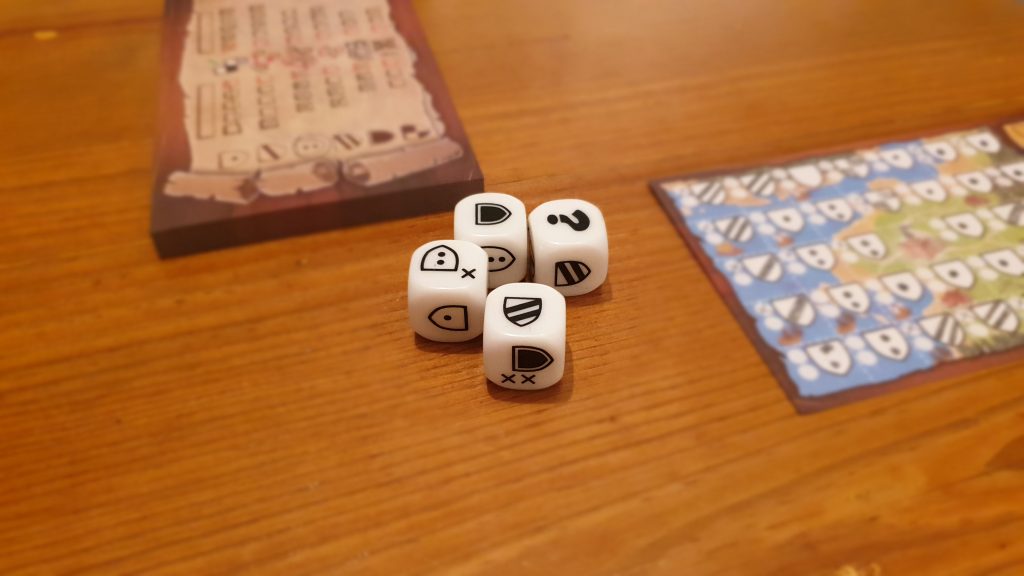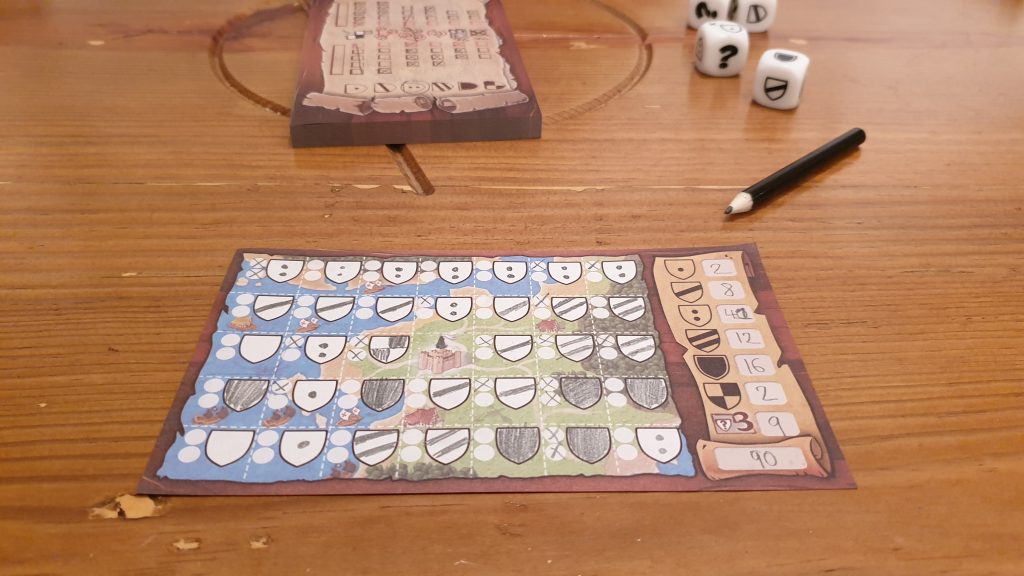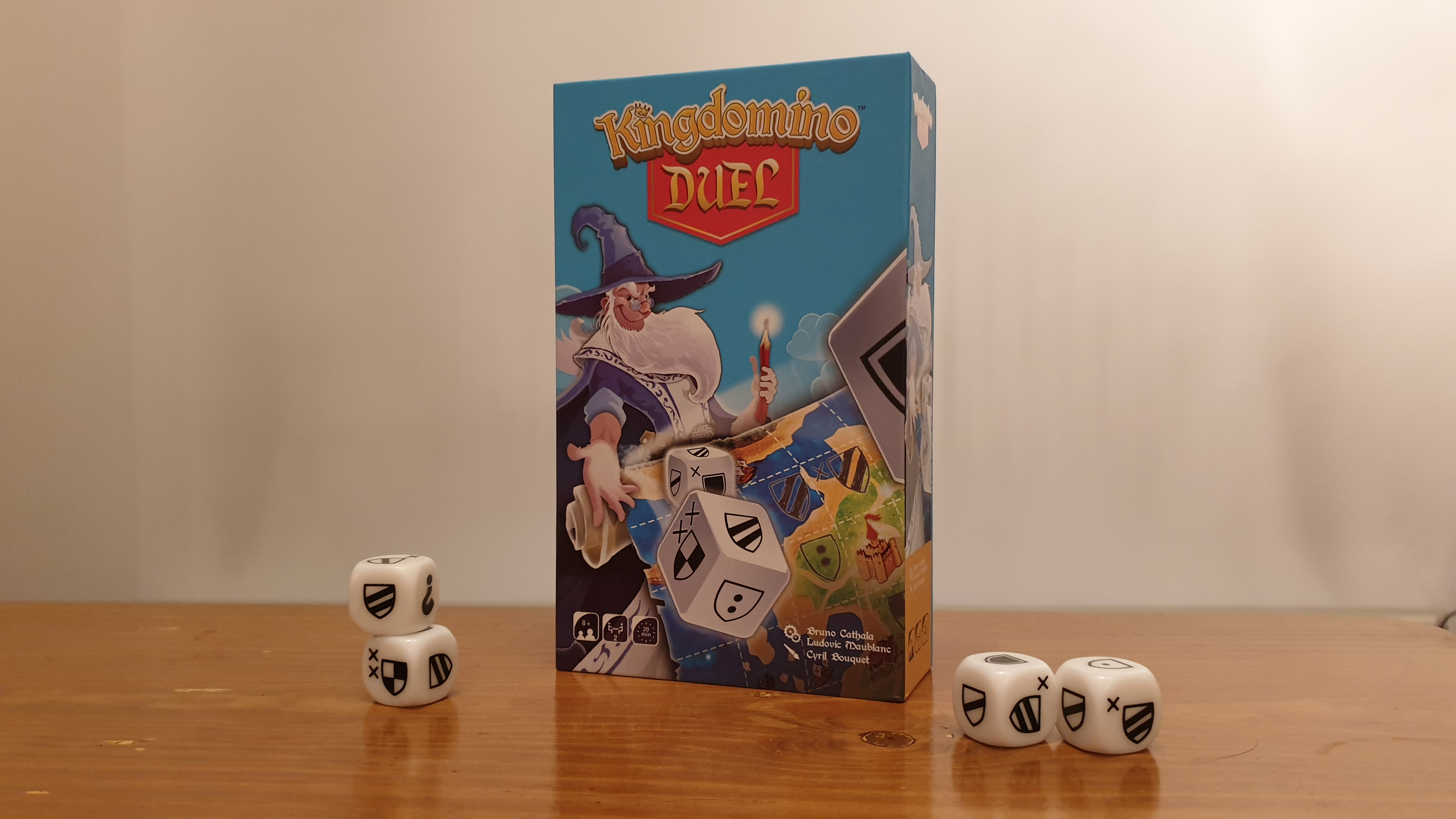Kingdomino Duel is the first roll & write in the Kingdomino series of games from publisher Blue Orange. Designed by Bruno Cathala and Ludovic Maublanc, as the name may suggest, the game is designed specifically for two players. In around 20 minutes, players will roll dice to form dominos, create a kingdom and hopefully rake in the points. However, with crowns being replaced with crosses is this the first sign of a lesser game? Let’s find out.
Removing the components from the box, players have little setup to do. Each player takes a sheet from the pad, placing another reverse side up between them. The sheets they have taken for themselves are where they will “write” their kingdom. The central sheet is the spellbook tracker, with each player using one half of the sheet. Aside from passing the dice to the starting player and getting the pencils the game is ready to go.
Each round players will obtain two dice to form a “domino” of two shield symbols. To do this the active player, Player A, first rolls the four dice. Player A claims one of the dice for themselves, before Player B claims their two dice. This leaves Player A with one final die that they must claim. Combining the two dice, each player can stitch them together in any adjacent way (excluding diagonals). This will leave the player with a domino that features up to two of the shield patterns, potentially including the ? wild symbol which can be any shield pattern.
Once both players have formed their domino it is time to add the shields to their kingdom. Much in the way Kingdomino treats dominos the players aren’t free to add them simply anywhere on their player sheet. With a central castle acting as a wild shield the player must first link to the castle. From then on, the player can build off a previous domino, or again from the castle, by matching one of the two shield symbols adjacently. As with King or Queendomino there is only a limited grid to build on. Therefore, it is possible to be unable to place dominos. If this occurs at any point then the domino is simply lost and at the end of the game the player will be left with gaps in their kingdom.

Some of the sides of the dice come with one or two crosses, on top of the shield pattern. When drawing the patterns onto a kingdom players need to also add the crosses to their player sheet, next to the appropriate shield of their domino. This is how players will score points at the end of the game. Each group of adjacent shields, of the unique patterns, can score points. Per grouping players multiply the number of shields with the number of crosses that feature in that group. For example, a 3 sized region with 2 crosses would be 6 points – while a 5 sized region with no crosses would be worth 0 points. Players keep going until their kingdoms should be full, via perfect domino placements, with whomever has the most points crowned the winner.
To shake things up there are spells (powers) that players can unlock. Whenever a player takes a shield without a cross they can cross off one box of that pattern on the central spellbook. Note, this is in addition to using the die normally. Whomever fills in the row of boxes of a shield pattern first gets the one time use power. These range from being able to instantly take two dice as Player A, or being able to place the two dice chosen separately, through to end game scoring bonuses. Each is helpful in its own way, plus by getting it you are taking the opportunity away from your opponent.
Using an ABBA player selection is ideal for keeping things fair. The first player guarantees themselves what works best for them, with the second player able to leave them a lacklustre die to pair with. Combine this with the opportunities the ? symbol or the powers open up to link large areas and players have lots of choice and chance to score huge areas. Play often starts out fairly loose, as players can take anything and match it to the wild castle. Yet, it slowly gets more cutthroat as the game progresses and the amount of good options reduces.
Production wise there isn’t much to rave about, nor is there much to fault or talk about. The dice are great to roll, with the symbols being clear and readable from across the table. Having the score pad be used on one side as the central powers board and the other the players kingdoms is a nice touch. The provided pencils are short but acceptable. My preference would be not to have a large paper pad and have dry wipe boards/markers, though this isn’t too hard to change.

Whether it is the Kingdomino branding, or the way two dice are effectively stitched together, the feeling of dominos is somehow present. It comes through less when looking at the player sheets, though the artwork that appears on them gives a kingdom like vibe – with the same spatial limitations (swapping a 5×5 grid for a 5×7 grid). One aspect that doesn’t quite make sense is the need for ditching the crown symbols. Being present on the tiles across King and Queendomino it doesn’t quite sit right putting crosses on the player sheet. It would make the game a few seconds longer if players drew crowns each time instead and would stay consistent with the rest of the franchise. It’s a tiny nitpick – it is more of an odd decision than an issue.
On its own Kingdomino Duel is a decent 2 player roll and write title. Certainly, some of the drive to play the game is the franchise it is part of. It is a small box title that doesn’t aim to entertain for hours, much like Kingdomino, but is a pleasant dice based filler. Part of Kingdomino’s attraction was the visual kingdom that grew out in front of players, something that is rather lost through scribbling on a player sheet. The powers make Kingdomino Duel decent to play, adding much needed additional decisions into the mix. Alas, the game is a little forgettable and doesn’t make it out of the “good” to play bracket. While I can see Kingdomino Duel being played for variety in the future, it won’t be a first choice over standard Kingdomino – even at 2.
[Editor’s Note: Kingdomino Duel was provided to us by Coiledspring Games for the review.]

